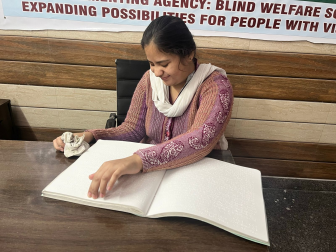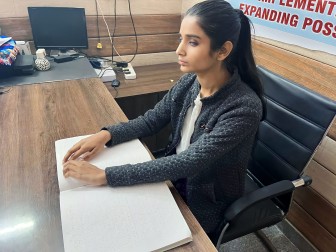Education is a powerful tool that can transform lives, and for individuals with blindness or visual impairments, it holds the key to unlocking untapped potential. However, for many of these students, access to quality education is a challenge—due to a lack of resources, specialized support, or funding. The need for education funding for the blind and visually impaired is critical not only to provide these students with the skills they need for independent living but also to ensure they can contribute meaningfully to society. This blog explores why investing in educational resources for visually impaired students is essential and how it can open doors to brighter futures.
Education serves as the foundation for personal growth and societal progress, and this holds true for blind and visually impaired individuals as well. The opportunity to learn and access academic resources equips them with the skills necessary to participate fully in society, whether through employment, social engagement, or personal development. Proper education can improve quality of life and increase self-sufficiency, allowing them to lead fulfilling and independent lives.
Blind and visually impaired students often face significant challenges in accessing education. These challenges include:
Lack of Accessible Materials: Textbooks, learning materials, and online resources may not always be available in formats that are accessible to visually impaired students. Braille books, audio books, or electronic materials are still not universally available, making it difficult for these students to keep up with their peers.
Insufficient Special Education Support: Not all schools have specialized staff or infrastructure in place to support students with vision impairments. This gap in educational support can limit the opportunities for these students to succeed academically.
Limited Access to Technology: Assistive technology, like screen readers or braille displays, can be expensive and is not always readily available in schools or for home use. Without access to such tools, students may struggle to engage with learning materials effectively.
Stigma and Misconceptions: Society still holds certain misconceptions about the abilities of blind and visually impaired individuals, which can affect both their access to education and how they are treated by educators and peers.
Investment in education funding is the key to overcoming these barriers. By prioritizing financial support, we can ensure that blind and visually impaired students have access to the tools and resources they need to succeed. Here are some key areas where funding can make a significant impact:
Accessible Learning Materials: Investing in the production of braille textbooks, audio books, and other digital resources can help bridge the gap in access to educational materials. Schools can benefit from funding that allows them to provide these materials to all students in need, ensuring no one is left behind.
Specialized Staff and Training: Funding can be used to train educators and employ specialized staff, such as orientation and mobility instructors, tactile graphics experts, and braille teachers, to provide individualized support for visually impaired students.
Assistive Technology: Providing funding for assistive technologies like screen readers, braille displays, and magnifiers can dramatically improve the learning experience for visually impaired students. With the right tools, students can engage with educational content more independently, enhancing both their academic performance and confidence.
Scholarships and Grants: Many blind or visually impaired students face financial barriers to attending college or vocational training programs. Scholarships, grants, and financial aid programs specifically for these students can make higher education more accessible and ensure that they have the opportunity to pursue their career goals.
Awareness and Advocacy: Funding can also be directed towards raising awareness and promoting advocacy for the rights of blind and visually impaired individuals. Educating the public and policymakers about the importance of inclusive education can lead to systemic changes that benefit all students, regardless of their visual abilities.
Investing in education for the blind and visually impaired does not just benefit the individual—it benefits society as a whole. When these students are given the tools and resources they need to succeed, they can contribute to a more diverse and inclusive workforce. They can become teachers, scientists, entrepreneurs, and leaders in their communities, enriching society with their unique perspectives and talents.
Furthermore, by fostering a culture of inclusivity and access to education, we break down barriers of discrimination and build a more empathetic society that values all individuals, regardless of their disabilities.
While governments and educational institutions play a critical role in funding programs for the blind and visually impaired, there is still much that can be done by individuals and organizations. Here are some ways you can make a difference:
Donate to organizations: Contributing to non-profits that provide educational resources and scholarships for blind and visually impaired students can make a direct impact.
Support policy changes: Advocate for stronger policies that support inclusive education and accessibility for visually impaired students at both the local and national levels.
Volunteer your time: Many organizations are looking for volunteers to help with tutoring, mentorship, or even creating accessible learning materials. Your time can make a significant difference in someone's education journey.
Raise awareness: By sharing information and spreading awareness about the challenges faced by blind and visually impaired students, you can help garner more support for funding and resources.
Investing in the education of blind and visually impaired students is one of the most powerful ways to ensure they can reach their full potential. By providing them with accessible materials, specialized support, and the right tools, we are giving them the opportunity to succeed academically and contribute meaningfully to society. Let’s work together to build a future where everyone, regardless of their visual abilities, has the chance to pursue their dreams and unlock their true potential.
By contributing to our feature donation campaigns, you are not just supporting us,
you are fostering independence, education, and accessibility for the people with blindness.
We are providing free shelter, food and educational support to the abandoned visually impaired girls residing at BWS.
₹1146562
raised of ₹2000000 Goal
57%
2 Days left
573 Supporters
Maa and Papa weren’t the happiest when I was born. They thought I was a burden to them.
₹768833
raised of ₹2000000 Goal
38%
2 Days left
589 Supporters
The Walking Canes have proved a useful tool to millions of blind people in navigating their environments with confidence and ease.
At our organization, we provide a nurturing environment for visually impaired girls, helping them lead fulfilling lives despite their challenges.
The following stories highlight the transformative journey of these remarkable individuals within our organization.

Hailing from Delhi, Sneha came to Blind Welfare Society in July 2023.
.jpeg)
Hailing from a small village of Gwalior district, Madhya Pradesh, Archana came to Blind Welfare Society in July 2023

Chhavi’s journey is a testament to the transformative power of education and the invaluable support provided by the Blind Welfare Society.